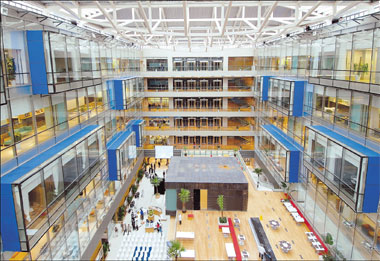 |
|
The environmentally friendly Nokia China Headquarters Building in Beijing.
|
According to its British architects Arup, the building is encased in a facade or skin made of two layers, allowing internal temperatures to be insulated from external environments. This alone reduces energy consumption by 14 percent. Overall the building reduces 20 percent more energy and 37 percent water usage.
Green materials
If the design for a green building is a recipe for a dish, then green materials are the ingredients. Any chef knows good ingredients are key," says Raefer Wallis, founder of A00 Architecture and giga-china.com, an online database of green materials available in China.
Having worked in Shanghai for the past eight years, Wallis realized choosing green materials is even more important than designing resource-efficient buildings.
"Buildings may be around for 150 years, but the materials you used -- the paints, varnishes and preservatives -- will be around for 150,000 years. The wrong choice means harmful materials in the building, then in landfills, leaking into soil and air and eventually making it back into the food chain," explains Wallis.
The name "giga" is an amalgamation of "green ideas" and "green action" - a platform for designers and architects to make better choices in materials.
Launched in April 2008, the Website was intended to be a small project to share information Wallis had personally accumulated on reliable green suppliers. After working on the carbon-neutral hotel URBN in 2007 on Jiaozhou Road, A00 was inundated with calls from other designers for recommendations of environmentally friendly materials.
Such is the lack of information in the market that the project has become "a green monster." Wallis has been asked to expand the Website by designers from across industries - landscape, industrial and fashion design. Even central government has noticed and is supporting its transition to an NGO.
"The problem is that research into green materials progresses at 1 kilometer an hour while construction proceeds at 100 kilometers an hour," says Wallis.
(Shanghai Daily January 5, 2009)